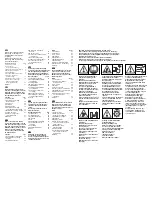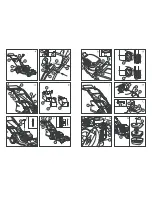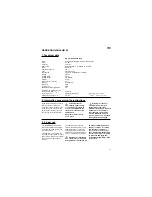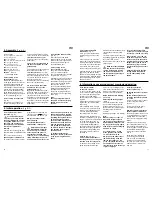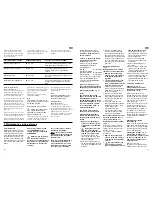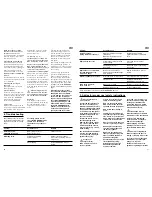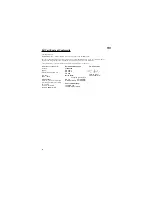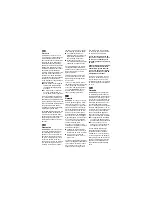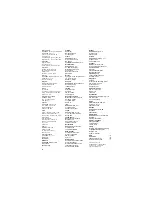
19
18
G
G
After having aerated heavily
moss-covered areas, it is re-
commended to resow the lawn.
This will help the affected lawn
to recover quickly.
The aerator cylinder use is
optional depending on the needs
and condition of the lawn.
The table below provides infor-
mation on the use of the aerator
cylinder.
6.4 Mowing with the
grass catcher
(Fig. I)
As soon as there are grass clip-
pings left on the lawn during
mowing and aerating, the grass
catcher should be emptied.
To remove the grass catcher (18)
lift the protective cover (27) on
your petrol Hattrick lawn mower
with one hand. With the other
hand hold the grass catcher (18)
by the carrying handle (17) and
remove the grass catcher (18)
upwards.
If the protective cover (27) is re-
leased, it automatically shuts and
covers the discharge opening.
If grass clippings stick in the dis-
charge opening, the mower may
be difficult to start. Pull the petrol
Hattrick lawn mower back about
1 m so that the grass clippings
drop out easily.
Afterwards, the grass catcher
should be emptied.
Note:
To ensure good collection, re-
gularly clean the grass catcher
inside and outside.
Attaching the grass catcher
A
Attach the grass catcher
only with the engine
switched off and the cutting
blade at a stand still.
Lift the protective cover (27) with
one hand. With the other hand
hold the grass catcher (18) by
the carrying handle (17) and in-
sert into the the discharge open-
ing from above.
Note:
If properly seated the protec-
tive cover (27) fits snugly to
the grass catcher (18).
Mowing without
the grass catcher
The protective cover (27) is
mounted in such a way that the
petrol Hattrick lawn mower can
be used without the grass catcher
with the protective cover (27)
closed. The clippings are ejected
onto the lawn below the protec-
tive cover (27).
Follow the manufacturer’s
instructions when replacing
the
blades, blade bar and for
aerator cylinder.
7.2 How to replace the blades,
blade bar and the aerator
cylinder
(Fig. K - M)
Please use only the Original
GARDENA Spare Blades:
Triangular blades
(HB 40)
Art. No. 4098
Rectangular Blades
( MulchCut HB 40)
Art. No. 4099
Aerator cylinder
Art. No. 4097
You can order these spare parts
from your GARDENA dealer
or directly from the GARDENA
customer service.
Never use spare parts or ac-
cessories which have not been
designed by the manufacturer!
Replacing the blades
(Fig. K)
Note :
The blade has two cutting
edges. If one edge has become
blunt the blade can be re-
versed. Broken blades must be
replaced immediately as it can
cause an imbalance problem.
Do not regrind the blades, it
will cause imbalance.
The blades must always be
replaced or reversed in pairs.
When replacing the blades
always use the new nuts and
bolts supplied with the spare
blades.
1.
Remove the spark plug in
order to avoid risk of injury
if the engine is accidentally
started.
2.
Empty the tank or run
A
the mower until the
tank is empty ! Make sure the
tank lid is properly closed.
Tilt the lawn mower to the
tank-located side; keep spark
plugs and sound absorber of
the motor upwards.
3. Hold the locking nuts (28) at
the back and unscrew the bolts
(29), using the TORX
®
-wrench
provided.
4. Reverse the blades (30) or
mount new blades (30) and
secure tightly (torque 25 Nm).
(During installation make sure
that the ratchet toothed locking
washers (31) are fitted under
the nuts (28) and that the nuts
(28) are on the top of the blade
bar (32).)
Replacing the blade bar
(Fig. L)
Damaged blade bars must be
replaced to prevent imbalance.
1.
Remove the spark plug in
order to avoid risk of injury
if the engine accidentally
is started.
2.
Empty the tank or run
A
the mower until the
tank is empty ! Make sure the
tank lid is properly closed.
Tilt the lawn mower to the
tank-located side; keep spark
plugs and sound absorber of
the motor upwards.
3. Release the hexagon head
bolt (33) with an appropriate
wrench (SW 13) and remove
the blade bar (32) from the
drive shaft.
4. Insert new blade bar and
tightly screw with the following
washers (in the same order):
a) fibre washer (34)
b) strain washer (35)
c) small steel washer (36)
and with the hexagon head
bolt (33) (Torque: 40 Nm).
Be sure that strain washer (35)
has been installed in the cor-
rect position (see fig. L 1).
Replacing the aerator cylinder
(Fig. M)
The aerator cylinder is subject
to natural wear and tear. If the
springs (37) are worn it will not
function correctly.
The aerator cylinder (38) must
be replaced.
1.
Remove the spark plug in
order to avoid risk of injury
if the engine is accidentally
started.
2.
Empty the tank or run
A
the mower until the
tank is empty ! Make sure the
tank lid is properly closed.
Tilt the lawn mower to the
tank-located side; keep spark
plugs and sound absorber of
the motor upwards.
3. Release screws (39) with
an appropriate Phillips head
screwdriver.
4. Remove the bearing sheet
steel (40).
5. Remove aerator cylinder (38)
together with end plate (41)
of the drive shaft (42) (square)
by tilting and pulling out.
6. Place new aerator cylinder (38)
onto drive shaft (42) (square);
stick on end plate (41) and
tighten with the bearing sheet
steel (40) in the casing.
7.3 Engine maintenance
Changing oil
(Fig.E)
Always change the oil when
the engine is hot and the tank
is empty and closed.
Carry out the first motor oil
change after 5 hours of operation,
then every 50 hours of operation
or once a year at the end of the
mowing season, depending on
which comes first.
In order to do this, open oil seal-
ing cap (21), tilt the mower so
that the old oil can flow into an
oil-trough. Dispose of waste oil
according to local regulations.
Position the mower on a level
surface again and fill it with motor
oil (0.6 l SAE 30 or 10 W 30)
(see 5.1).
Checking and cleaning
the spark plug
Clean a contaminated spark plug
with a brass wire brush and rag.
Check the electrode gap (setting :
0.75 mm gap). Replace a badly
worn or damaged plug.
Cleaning the air filter
(Fig. N)
Cleaning the air filter is ne-
cessary every 3 months or after
25 hours of operation. In ex-
treme dusty conditions do so
more frequently.
Remove screw (43).
Fully remove air filter by pulling
sideways and / or from the front.
Use of the aerator cylinder
Cutting height setting
Function of the aerator cylinder
Deep aeration of the soil
30 - 35 mm
The aerator springs penetrate up to 7 mm
deep depending on the type of soil.
Aeration of the soil surface
35 - 40 mm
The aerator springs remove moss,
matting, and weeds rooting near the
surface.
Combing the lawn
40 - 45 mm
The aerator springs remove residues from
the lawn.
Gathering grass clippings etc.
40 - 55 mm
The aerator springs remove even wet or
trodden-in grass clippings etc. from the
lawn.
7.1 Maintenance
Maintenance includes all jobs
which keep your petrol Hattrick
lawn mower in perfect working
order. By regularly checking the
unit (firm seating of screw con-
nections, cracks, damage) and
replacing defective or worn parts
you can prevent accidents and
failure.
Repairs may only be carried
out by GARDENA service
centres or dealers authorised
by GARDENA.
A
Attention: Always detach
the spark plug before
working on your petrol Hattrick
lawn mower (for checking and
maintenance) to prevent risk
of injury!
For security reasons, replace
the tank lid if damaged.
Never clean your petrol Hattrick
lawn mower with running water,
in particular with water under
high pressure.
Store your petrol Hattrick lawn
mower in a dry place where
it is protected from frost. The
lawn mower should be stored
out of the reach of children.
7. Maintenance, service, storage
Содержание 4005
Страница 3: ...35 ...


